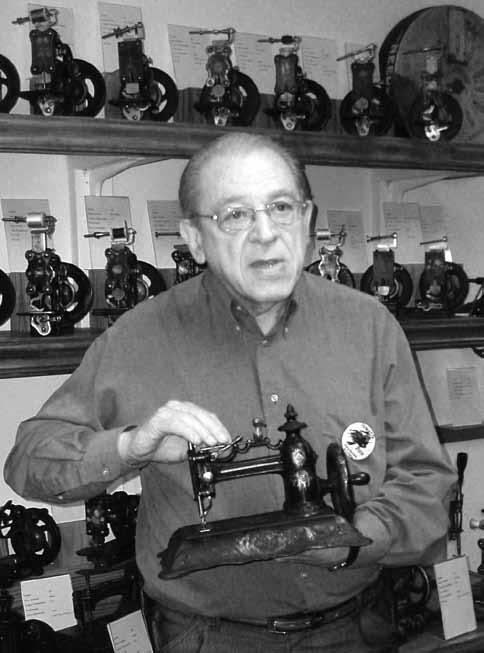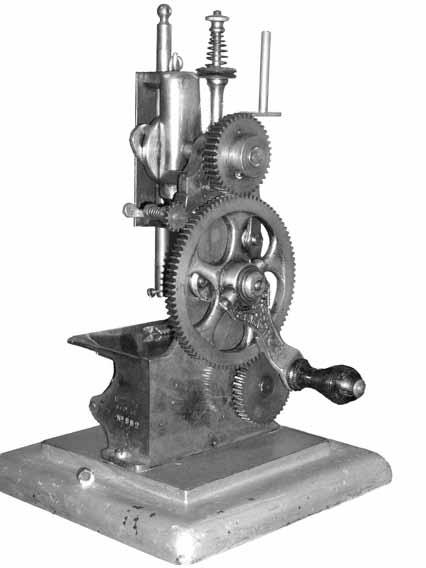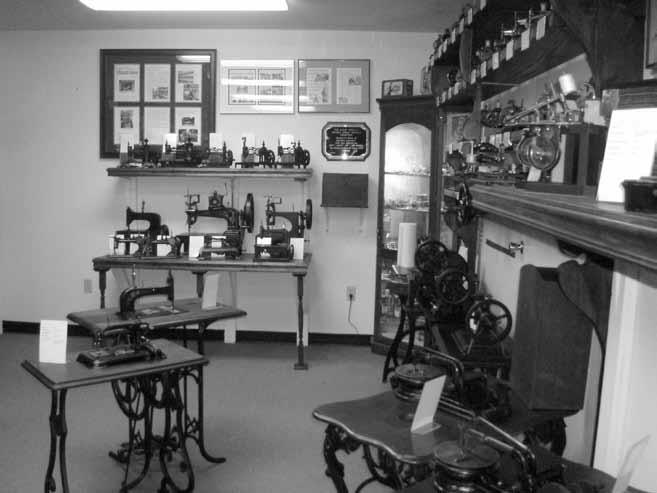An Interview With Antique Sewing Machine Collector Harry Berzack
Part II

By Maribeth Keane and Jessica Lewis,
Collectors Weekly Staff
ISMACS News
Issue 98
June 2010
Harry Berzack, co-host of the 2009 Charlotte Convetion, is a collector of 19th-century and pre-World War II sewing machines. Unlike many collectors in this field, Harry's 500- piece collection is international in scope. Recently, the online publication Collectors' Weekly spoke with Harry about his antique machine collection, the history of sewing machines, their uses and the major manufacturers.
Collectors Weekly: Do you collect modern machines or do you stop at a specific time period?
Berzack: The latest machines I have are from the 1940s. One of them is from the Second World War. Singer came out with a surgical sewing machine used in the field to stitch wounds. There aren't many of them around, so that's worthwhile. Another machine I have from the '40s is still in its original packing case with the label on it where it was railed to a customer in Munster, Indiana. But I would say that probably 90 percent of my machines pre-date 1900.
CW: Were sewing machines first used in the home?
Berzack: Actually, no. There's no one inventor of the machine. Different people had different ideas. There was a Frenchman whose first machines went into a factory in Paris—the workers were so upset because they thought that they were going to lose jobs. So the earliest machines were really designed for factories, but it very soon became a household thing.

A lot of the companies didn't necessarily market under their own name. The department stores had departments selling sewing machines. Sears Roebuck had machines with decals with their name on it. Those machines could've been made by one of three or four different factories, and if you're really into it, you can work out, "Well, this sewing machine was made for Montgomery Ward and this was made for Macy's." There are giveaways as to who the actual maker was but there are thousands of names out there.
CW: How did Singer become so well-known?
Berzack: Because of marketing, not invention. They were not great innovators, but they were unbelievable marketers. They bought people out. If you're making a million machines a year and you have a factory in the States and a factory in England and you control your own distribution, you get into a very strong position and it's not easy for people to fight you or dislodge you.
A lot of people copied them. The classic Singer machine in the early days, the mass-market machine, was the Singer Model 12, and there were literally hundreds of people who knocked it off in one way or another. There was a tremendous amount of copying. There was some licensing, but most of it was illegal copying. In fact, there were even people who copied the Singer emblem, the "S" emblem. People tried to jump on the bandwagon.
Singer owned its own companies all over the world. They have never badged a machine, which is putting someone else's name on, and they control their own distribution. They have their own subsidiary companies and factories in probably 20 to 30 countries, like Italy, Brazil, Scotland, Australia, South Africa, Taiwan. They had a big presence in Russia, too, prior to the revolution. You can take out an atlas and wherever your finger falls, Singer probably had a factory there.

Singer 24-35 (and others in this article) from the Berzack collection.
CW: How did the machine evolve from the 1800s to the 1900s?
Berzack: The early machines tried to replicate the movement of a hand pulling a needle all the way through a piece of fabric and then pushing it back the other side, like you would hand stitch today. Then came the advent of the chain stitch machine and everything depended on the needle forming a loop and either catching the loop or having a shuttle go between the needle and the outer thread through the loop to capture the thread. Then the needle comes up and goes through the top of the fabric again. That became the basis of sewing. It became a matter of, "How does that loop get formed?"
The next thing was, as I said, the shuttle moving through the loop. You had what was called a round bobbin, which is basically the way lock-stitches form today. The earliest bobbins were Wheeler & Wilson and that goes back to the 1860s. Today you don't have shuttles at all because everything is either bobbin or loop or chain-stitch machines.
CW: How many different parts are there to a sewing machine?
Berzack:
That's like asking how long is a road. There are some very simple machines that aren't very effective and don't have many parts. A modern industrial sewing machine could have 1,500 to 2,000 parts in it, but you could also find a machine with 20 parts. They're not very effective, but they exist.
In the early machines, which were invariably made out of cast iron, one turn of the handle gave you one stitch. One of the first innovations was to gear it so that one turn of the handle gave you two stitches so you'd get double the production. Today you have diecast, aluminum and plastic machines that are capable of doing 9,000 stitches a minute.

CW: Are repair parts still available for older machines? Berzack:
No. People who are really into it have to know a little engineering and make their own parts. If you use an antique machine, then you're basically using one of the massproduced machines and their parts are easier to find. Singer made a million machines a year of the class 12, so they probably made about 10 million machines total and there could well be half a million of them that are still running. It's comparatively easy to pick up an old machine for parts to adapt or modify. But the very old stuff? If you're missing something, that's it.
CW: When you collect sewing machines, are there specific things you look for?
Berzack: I look for rarity, condition, technical differences and what would have been an innovation at the time. I try to fill holes in my collection with rarer machines. There are rare machines that come up every now and again on eBay. Sometimes I get them and sometimes someone's more generous than I am. It's very difficult today to find machines in antique shops or flea markets. Odd ones still pitch up but not as much as they used to.
A lot of the antique shops have no idea how to value these things. Say there was a Singer that was patented in 1860. Because it's old, it would be marked at, say, 300 bucks, but the value of it is probably closer to $25 because Singer made half a million of them that year so they're not rare. They assume that because it's old, it must be valuable.

Every sewing machine collector I know has a machine that they overpaid for and a machine that they're sorry they sold.
As soon as you go beyond the basic machines from the 1900s, what are called the quilters' machines, you have to start educating yourself or you're going to hit the poor house before you know where it is, and you'll have nothing to show for it. Anyone who doesn't come to the shows is going to miss a great opportunity to educate themselves.
Collectors' Weekly hosts a thriving Sewing page at www.collectorsweekly.com/sewing/
©2009 http://www.collectorsweekly.com/ Originally published by Collectors' Weekly and reproduced with their permission.





